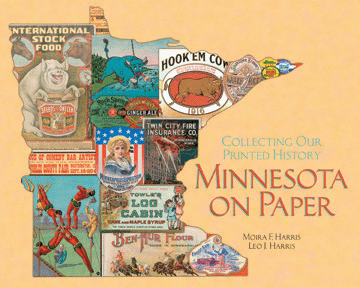Ephemeral Impressions: Minnesota on Paper
Connie Wanek reviews "Minnesota on Paper: Collecting Our Printed History" (University of Minnesota Press). It's a detailed account of commercially printed imagery in Minnesota, and provides a great view of what graphic design has been in the state.

Minnesota on Paper: Collecting Our Printed History, by Moira F. Harris and Leo J. Harris, foreword by Barry Casselman and Roger G. Kennedy. University of Minnesota Press, $24.95.
Perhaps you have held onto those Bob Dylan ticket stubs for years, or maybe you kept a pristine bumper sticker from the last political campaign you cared about. You might be a beer drinker who has also retained examples of breweriana: beer labels, cans, bottles, and coasters. If so, you are collecting ephemera, and the handsome new book from the University of Minnesota Press, Minnesota on Paper: Collecting Our Printed History may be exactly what you need to justify your activities to your roommate or mother.
What are ephemera? In the context of this book, the word “ephemera” means paper goods that were not meant to last beyond “an original one-time use.” Ephemera can include a wide range of items, including sheet music, menus, calendars, posters and broadsides, match book covers, and even those little PLU stickers on Minnesota apples that you might, if you’re like me, have eaten by accident on a number of occasions. Why would someone collect PLU stickers? If you have the collecting gene, you do not need to ask that question.
Minnesota on Paper is, first and foremost, a picture book, with over 270 color illustrations. Almost every page includes something of visual interest, from charming turn of the (nineteenth) century advertisements for animal feed featuring a laughing pig with a spoon in one hand and a corn cob in the other, to Ruby Curtis’ eighth-grade report card (she did rather badly in arithmetic during the 1905-6 school year in Osakis, Minnesota), to a postcard featuring a Cass Lake Native American in headdress at 128 years of age, a man known, oddly, as John Smith.
The prose, too, amuses and enlightens, providing detailed background for various types of ephemera. I learned that some collectors, called “tryroemiophilists,” specialize in Camembert cheese labels. And interestingly, in 1895 there were 550 cigar factories in Minnesota, and tobacco was widely grown in our state and neighboring Wisconsin. Cigar production was highly localized, with most cigars sold within a day’s walk of the factory where they were made. Ephemera are an open window into history, and by focusing on Minnesota ephemera, authors Moira and Leo Harris have also created a fascinating record of ordinary life in our state from territorial days to the present.
Graphic designers will find Minnesota on Paper to be a source of real interest and possible inspiration, both for the instructive illustrations and because the book itself is so beautifully designed. I love the book’s visual details, from the appearance of page numbers to the slender ribbons of color on the outside edges of each page. If you already collect ephemera, this book is not a price guide. Rather it is an overview of who created Minnesota ephemera, and how, and why certain paper objects, meant to be temporal, have lasting interest. The book includes an index, and in the “Notes” section one can find an informal bibliography.
There is a certain poetry in the notion of ephemera, and in the close look the authors have taken at objects and images that resonate so deeply. Modern historians are altering the way we regard the past: rather than focusing on a series of presidents and kings and a sad record of one conflict after another, we are now examining the way common people lived, and ephemera help tell this parallel, equally meaningful tale. Minnesota on Paper may change the way you look at your next empty wine bottle, taking note of its attractive, highly collectible label, and carefully removing it for your growing archives.
Connie Wanek 1/2/07